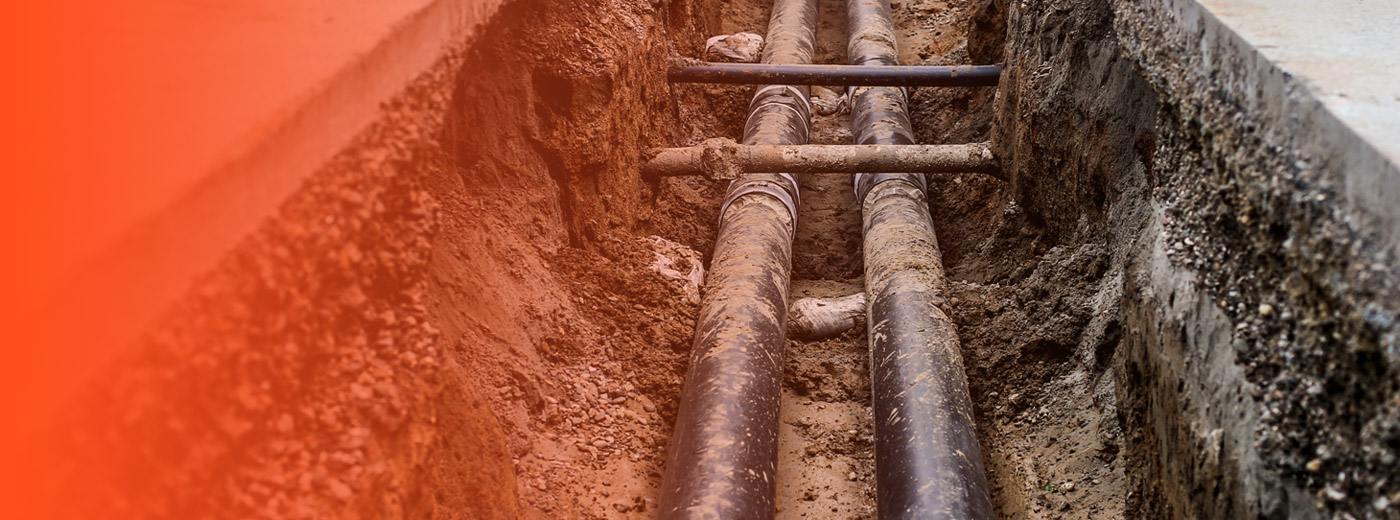Blogs
What Causes Pipeline Damage?
September 20, 2022


Not far below the surface of our cities and neighborhoods, 2.2 million* miles of pipes carry about about 39 billion* gallons of safe, clean water to U.S. homes and businesses every day. Sometime later, another 1.3 million* miles of sewage pipes carry away the waste. Throughout the world, millions of miles more. All of this makes understanding the causes of pipeline damage in order to prevent it a high priority for businesses and government agencies.
Unfortunately, pipeline damage is inevitable. Given the vast extent of underground systems, the critical role they play, and the negative impact of breaches, a fast, efficient method to locate and assess pipeline damage before complete failure occurs is a high priority.
Underground water and waste systems are composed of a variety of materials, and none are impervious to pipeline damage. Metal pipes include cast and ductile iron, galvanized steel, and copper. Non-metal pipes may be vitrified clay (clay and shale blended at high temperatures) or reinforced concrete. Plastics like PVC (polyvinyl chloride), HDPE (high-density polyethylene), and fiberglass are also used.**
The methods for assessing pipeline damage have evolved quite slowly. Even newer methods are restrained by their very limited range and the inefficiency of only being able to assess small areas of pipes at once. Los Angeles alone has 6,700*** miles of water pipes and 9,500**** miles of sewer pipes. However, in the last few years, newer technologies to assess pipeline damage without these limitations have emerged.
Pipeline assessments typically include digging and visual inspection, ground penetrating radar, acoustic listening devices, and closed circuit cameras. Historical information such as age, material, soil conditions, and maintenance records are also essential.
But when you think about the thousands of miles of pipes that serve an average city, these methods all share the same limitations. One complication is that not all methods work on all pipe materials. They are also intended to examine a limited length of a specific pipe, not an entire system. And without additional information, they don’t know which pipes to examine until significant problems – including catastrophic failure – alert them.
This makes most traditional methods either too expensive or too complicated to proactively and regularly assess an entire system for pipeline damage.
The newest addition to the range of pipeline damage assessment technology uses data gathered by satellite-based radar during repeated orbital passes. Algorithmic analysis of the data indicates where pipeline damage or deficiency is most acute relative to the system. This system by ASTERRA, known as MasterPlan, is a genuine paradigm shift in the way individuals and companies can assess pipeline damage.
Satellite observation and analysis can proactively assess an entire system for pipeline damage or deficiency with several satellite passes over a period of a few months. It can also continue to monitor for further changes. Rather than data on just a specific section of pipe, a data layer in their GIS will show the condition of the entire system, with deficiency ratings broken into five levels.
The system is “pipe agnostic,” meaning pipe material doesn’t matter. It’s also non-invasive and requires much less crew and staff support.
Accidents during ground excavation are responsible for over 25%***** of serious pipeline incidents. Another issue is age. The average age of the in-ground pipe system is about 45 years, with some pipes having a century or more of service. During that time, corrosion, incorrect operation, material failure and construction weaknesses, damage from the natural or artificial movement of the surrounding earth, and chemical or electrical properties of the soil are making their contributions to pipeline damage.
Pipeline damage comes in a number of different forms with various ramifications. These may include:
Other types of pipeline damage include splitting and shearing of bell joints, where the end of one pipe inserts into a wider diameter and joined. Corrosion pitting may result in increasing seepage through pinhole leaks or larger.
All damaged pipelines require attention. Small cracks grow into larger ones, and small leaks grow.
For water utilities, ignoring damaged pipes can lead to significant non-revenue water (NRW), expensively processed and then lost to leaks in damaged pipes. This means the water, energy, money (and resulting CO2 emissions) have all been wasted. Blowout failures can deprive homes and businesses of water. Processed water leaked into nature can introduce chlorine to sensitive habitats, imperiling wildlife.
For wastewater utilities, pipeline damage leads to sewage (toxins, pathogens) leaking into the environment. Not only does this cause ecological damage, but it can also mean fines, consent decrees, and negative publicity.
Locating and monitoring pipeline deficiencies and damage have become exponentially more efficient with the advent of satellite-based analysis.
Please visit ASTERRA’s MasterPlan Pipeline Monitoring & Deficiency Assessment to learn more about how satellite-based monitoring works and how it can help you.
*The American Society of Civil Engineers, 2021 Infrastructure Report Card
** Water World, The Perfect Pipe
***The Los Angeles Times, L.A.’s aging water pipes; a $1-billion dilemma
****Public Works LA County, Water Resources: Sewer
*****Pipeline & Hazardous Materials Safety Administration